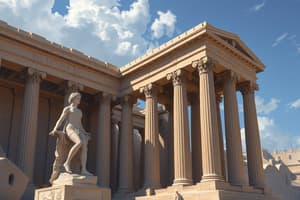Podcast
Questions and Answers
What does classical art refer to?
What does classical art refer to?
- Art form from the 20th century
- Art form from the Middle Ages
- Art form from Greece and Rome (correct)
- Art form from the Renaissance
What does classicism favor in the arts?
What does classicism favor in the arts?
The classical period and classical antiquity as standards for taste.
What is described by the term classical period?
What is described by the term classical period?
A long period of time in cultural history when the Mediterranean Sea was the center.
The classical period began after _____________
The classical period began after _____________
What is the Parthenon?
What is the Parthenon?
Who was Pericles?
Who was Pericles?
What did Pheidias create?
What did Pheidias create?
Who was Pythagoras?
Who was Pythagoras?
What is considered the greatest work of the classical period?
What is considered the greatest work of the classical period?
Greek art influenced Roman art and both were an inspiration for the _____________
Greek art influenced Roman art and both were an inspiration for the _____________
How are Greeks characterized in terms of art?
How are Greeks characterized in terms of art?
How are Romans characterized in terms of art?
How are Romans characterized in terms of art?
What did Hellenistic arts do in terms of sculpture and literature?
What did Hellenistic arts do in terms of sculpture and literature?
When was the time that almost no Greek painting survived?
When was the time that almost no Greek painting survived?
What survived in Greek art from the archaic age?
What survived in Greek art from the archaic age?
What subjects are included in ancient Greek paintings?
What subjects are included in ancient Greek paintings?
What is linear perspective?
What is linear perspective?
Who was Agatharchus of Samos?
Who was Agatharchus of Samos?
What does scenography relate to in art?
What does scenography relate to in art?
What are considered European achievements in architecture?
What are considered European achievements in architecture?
What served as models for architects of the Italian Renaissance?
What served as models for architects of the Italian Renaissance?
What was Michelangelo known for?
What was Michelangelo known for?
The _____________ were practical people and wanted their art and architecture to be useful.
The _____________ were practical people and wanted their art and architecture to be useful.
Who were the most powerful people in Italy during the classical period?
Who were the most powerful people in Italy during the classical period?
Where was painting usually done in Pompeii?
Where was painting usually done in Pompeii?
What were the most popular colors in Roman art?
What were the most popular colors in Roman art?
Flashcards are hidden until you start studying
Study Notes
Classical Art and Development
- Classical art originates from ancient Greece and Rome, serving as a cornerstone in Western art history.
- Classicism describes an artistic preference for the styles and standards of the classical period, particularly influencing taste and imitative practices.
Timeframe and Influences
- The classical period marks a significant era when the Mediterranean Sea became a cultural epicenter.
- Greek poetry, notably the works of Homer, alongside the rise of Rome and Christianity initiates this transformative period.
Artistic Innovations and Characteristics
- Classical Greek art emerges from earlier influences, showcasing stylistic remnants in early statues.
- Kouroi, which are stone figures, represent a foundational aspect of Greek sculpture.
Artistic Media and Themes
- Ceramic paintings and sculptures illustrate the evolution of Greek art, with limited large paintings surviving from this time.
- Depictions in ancient Greek paintings feature mythological themes, including Medusa, centaurs, and Olympic athletes.
Landmark Achievements
- The Parthenon stands as a pinnacle of achievement in Athens, dedicated to the goddess Athena.
- Pericles, a prominent leader of Athens, played a vital role in the cultural advancements during the classical period.
- Pheidias was instrumental in creating a renowned statue of Athena from ivory and gold at the Acropolis.
Significant Historical Events
- The classical period follows the Greek victory over the Persians, establishing a foundation for artistic and cultural developments.
Artistic Influences and Legacies
- Greek art significantly influenced Roman art, which in turn inspired the Renaissance.
- Hellenistic arts emphasized realism, notably in sculpture and literature, focusing on life-like representations.
Key Figures and Notions
- Pythagoras, a notable mathematician, contributed to the intellectual environment of the period.
- The massive statue of Zeus was considered a remarkable contribution to the artistic heritage of the classical age.
Roman Contributions and Characteristics
- Romans prioritized practicality, designing art and architecture with utility in mind, including urban planning, bridges, and public amenities.
- Etruscans, influential in Italy, hailed from Asia Minor and settled in Tuscany, impacting local cultures.
Architectural Developments
- Innovations during this period include the dome, groin vault, and the extensive network of roads, showcasing European achievements in architecture.
- Michelangelo (1475-1564) is recognized for his design contributions to St. Peter's Basilica, demonstrating the lasting impact of classical ideals.
Color and Decoration
- In Roman art, the colors black and cream-white were particularly favored, reflecting aesthetic preferences of the era.
- Frescoes were commonly used in places like Pompeii for decorative purposes, executed on interior walls.
Decline and Preservation
- By the 20th century, a significant loss of ancient Greek paintings occurred, with few surviving examples despite their historical importance.
- Vases from the archaic age are among the remnants that provide insight into ancient Greek artistic practices.
Studying That Suits You
Use AI to generate personalized quizzes and flashcards to suit your learning preferences.




